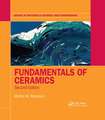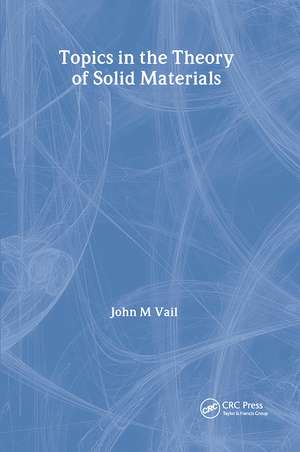Topics in the Theory of Solid Materials: Series in Materials Science and Engineering
Autor J.M. Vailen Limba Engleză Hardback – 13 sep 2023
Topics in the Theory of Solid Materials is eminently suitable for graduates and final-year undergraduates in physics, materials science, and engineering, as well as more advanced researchers in academia and industry studying solid materials.
Din seria Series in Materials Science and Engineering
-
 Preț: 356.63 lei
Preț: 356.63 lei - 25%
 Preț: 1052.04 lei
Preț: 1052.04 lei - 25%
 Preț: 767.88 lei
Preț: 767.88 lei - 18%
 Preț: 1384.61 lei
Preț: 1384.61 lei -
 Preț: 448.08 lei
Preț: 448.08 lei - 12%
 Preț: 312.43 lei
Preț: 312.43 lei - 11%
 Preț: 306.98 lei
Preț: 306.98 lei -
 Preț: 442.89 lei
Preț: 442.89 lei - 26%
 Preț: 986.91 lei
Preț: 986.91 lei - 10%
 Preț: 327.80 lei
Preț: 327.80 lei - 13%
 Preț: 338.33 lei
Preț: 338.33 lei - 11%
 Preț: 320.78 lei
Preț: 320.78 lei -
 Preț: 436.75 lei
Preț: 436.75 lei - 12%
 Preț: 318.12 lei
Preț: 318.12 lei - 12%
 Preț: 312.43 lei
Preț: 312.43 lei - 22%
 Preț: 521.69 lei
Preț: 521.69 lei - 12%
 Preț: 317.65 lei
Preț: 317.65 lei - 11%
 Preț: 318.90 lei
Preț: 318.90 lei - 18%
 Preț: 1128.94 lei
Preț: 1128.94 lei - 30%
 Preț: 694.52 lei
Preț: 694.52 lei - 18%
 Preț: 1109.18 lei
Preț: 1109.18 lei - 18%
 Preț: 816.09 lei
Preț: 816.09 lei -
 Preț: 443.07 lei
Preț: 443.07 lei -
 Preț: 360.21 lei
Preț: 360.21 lei - 21%
 Preț: 366.70 lei
Preț: 366.70 lei - 25%
 Preț: 1529.60 lei
Preț: 1529.60 lei - 25%
 Preț: 1175.43 lei
Preț: 1175.43 lei - 31%
 Preț: 1145.07 lei
Preț: 1145.07 lei - 24%
 Preț: 650.32 lei
Preț: 650.32 lei
Preț: 851.40 lei
Preț vechi: 1142.61 lei
-25% Nou
Puncte Express: 1277
Preț estimativ în valută:
162.93€ • 169.14$ • 135.86£
162.93€ • 169.14$ • 135.86£
Carte tipărită la comandă
Livrare economică 24 martie-07 aprilie
Preluare comenzi: 021 569.72.76
Specificații
ISBN-13: 9781138414105
ISBN-10: 1138414107
Pagini: 384
Dimensiuni: 156 x 234 mm
Greutate: 0.66 kg
Ediția:1
Editura: CRC Press
Colecția CRC Press
Seria Series in Materials Science and Engineering
ISBN-10: 1138414107
Pagini: 384
Dimensiuni: 156 x 234 mm
Greutate: 0.66 kg
Ediția:1
Editura: CRC Press
Colecția CRC Press
Seria Series in Materials Science and Engineering
Public țintă
UndergraduateRecenzii
"What are dislocations? What are phonons? What is phonon transport? This text describes all that and more in lucid language. If you're into materials and would like to relearn the undergraduate condensed matter physics that you wished you knew, this is the book to read."
-Biswajit Banerjee, University of Utah, Salt Lake City, USA
-Biswajit Banerjee, University of Utah, Salt Lake City, USA
Cuprins
Preface.1 Strainand stress in continuous media1.1Introduction1.2Deformation: strain and rotation1.2.1The strain tensor1.2.2The rotation tensor1.3Forces and stress1.4Linear elasticity1.4.1Hooke’s law1.4.2Isotropic media1.4.3Elastic moduli1.4.4Stability conditions1.5Equilibrium2Wave propagation in continuous media2.1Introduction2.2Vector ?elds2.3Equation of motion2.4Wave propagation2.4.1Shear and rotational waves2.4.2Dilatational or irrotational waves2.4.3General discussionAppendix to Chapter 23Thermal properties of continuous media3.1Introduction3.2Classical thermodynamics3.2.1The Maxwell relations3.2.2Elastic constants, bulk moduli and speci?c heats3.3Thermal conduction and wave motion3.4Wave attenuation by thermal conduction 4Surface waves4.1Introduction4.2Rayleigh waves4.3Boundary conditions4.4Dispersion relation4.5Character of the wave motion5Dislocations5.1Introduction5.2Description of dislocations5.3Deformation ?elds of dislocations5.3.1Screw dislocation5.3.2Edge dislocation5.4Uniform dislocation motion5.5Further study of dislocations6Classical theory of the polaron6.1Introduction6.2Equations of motion6.3The constant-velocity polaron6.4Polaron in a magnetic ?eld: quantization7Atomistic quantum theory of solids7.1Introduction7.2The hamiltonian of a solid7.3Nuclear dynamics: the adiabatic approximation7.4The harmonic approximation7.5Phonons7.5.1Periodic boundary conditions for bulk properties7.5.2The dynamical matrix of the crystal7.5.3The normal modes of crystal vibration7.5.4Electrons and phonons: total energy7.6Statistical thermodynamics of a solid7.6.1Partition function of the crystal7.6.2Equation of state of the crystal7.6.3Thermodynamic internal energy of the crystal;phonons as bosons7.7Summary8Phonons8.1Introduction8.2Monatomic linear chain8.3Diatomic linear chain8.4Localized mode of a point defect 9Classical atomistic modelling of crystals9.1Introduction9.2The shell model for insulating crystals9.3Cohesive energy of a crystal9.4Elastic constants9.5Dielectric and piezoelectric constants10Classical atomic di?usion in solids10.1Introduction10.2The di?usion equation10.2.1Derivation10.2.2Planar source problem10.3Di?usion as a random walk10.4Equilibrium concentration of point defects10.5Temperature dependence of di?usion: the Vineyard relationAppendix to Chapter 10: Stirling’s formula11Point defects in crystals11.1Introduction11.1.1Crystals and defects11.1.2Modelling of point defects in ionic crystals11.2Classical di?usion11.2.1Copper and silver di?usion in alkali halides11.2.2Dissociation of the oxygen-vacancy defect complexin BaF211.3Defect complex stability11.4Impurity charge-state stability11.4.1Nickel in MgO11.4.2Oxygen in BaF211.5Optical excitation11.5.1Frenkel exciton and impurity absorption in MgO11.5.2Cuþ in NaF11.5.3O- in BaF211.6Spin densities11.6.1F center in NaF11.6.2F2þ center in NaF11.6.3F2þ * center in NaF11.7Local band-edge modi?cation11.7.1Valence band edge in NiO : Li11.7.2Conduction band edge in BaF2 : O-11.8Electronic localization11.9Quantum di?usion11.10E?ective force constants for local modes 11.11SummaryAppendix to Chapter 11: the ICECAP method12Theoretical foundations of molecular cluster computations12.1Introduction12.2Hartree–Fock approximation12.2.1The approximation12.2.2Normalization12.2.3Total energy12.2.4Charge density and exchange charge12.2.5The single-particle density functional12.3The Fock equation12.3.1The variational derivation12.3.2Total energy algorithm12.3.3Solution of the Fock equation12.4Localizing potentials12.5Embedding in a crystal12.5.1Introduction12.5.2Approximate partitioning with a localizing potential12.5.3Summary12.6Correlation12.7One-, two- and N-particle density functionals12.7.1Introduction12.7.2Density functional of Hohenberg and Kohn12.7.3Reduced density matrices12.7.4The many-fermion system12.7.5The density functional and the two-particle density operator13Paramagnetism and diamagnetism in the electron gas13.1Introduction13.2Paramagnetism of the electron gas13.2.1The total energy13.2.2The magnetic susceptibility13.2.3Solution at low temperature13.2.4Solution at high temperature13.3Diamagnetism of the electron gas13.3.1Introduction13.3.2The Landau levels13.3.3The Fermi distribution13.3.4Energy considerations13.3.5Magnetization: the de Haas–van Alphen e?ect13.3.6Diamagnetism at T0Appendix to Chapter 13 14Charge density waves in solids14.1Introduction14.2E?ective electron–electron interaction14.3The Hartree equation: uniform and periodic cases14.3.1The Hartree approximation14.3.2The uniform solution14.3.3The periodic solution14.4Charge density waves: the Mathieu equation14.4.1The Mathieu equation14.4.2Solution away from the band gap14.4.3Solution near the band gap14.4.4The self-consistency condition14.4.5The total energy14.5DiscussionReferencesExercisesAnswersAuthor indexSubject index
Descriere
Presents an introduction to a wide selection of topics in solid materials. This book covers stress and strain, wave propagation, thermal properties, surface waves, polarons, phonons, point defects, magnetism, and charge density waves.
